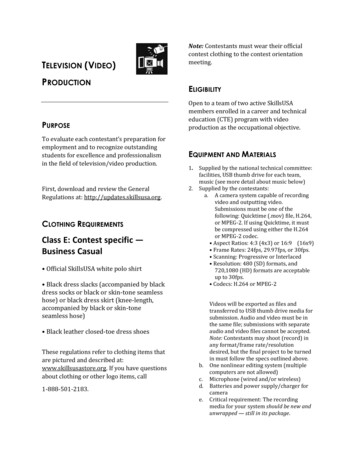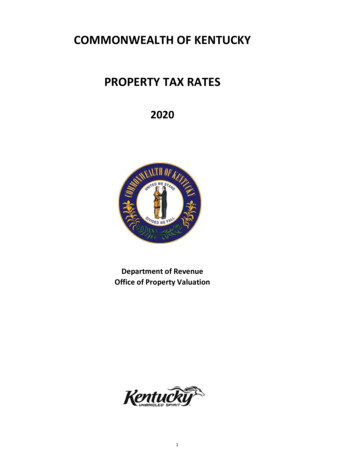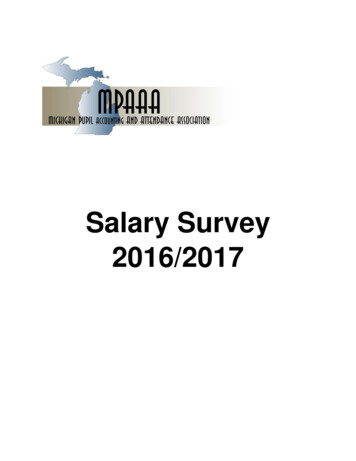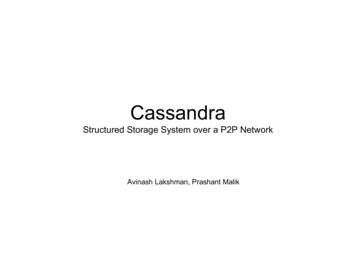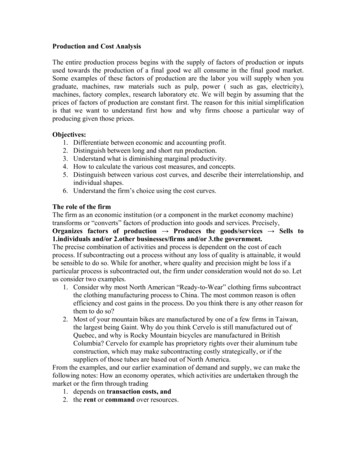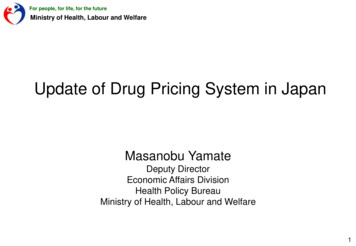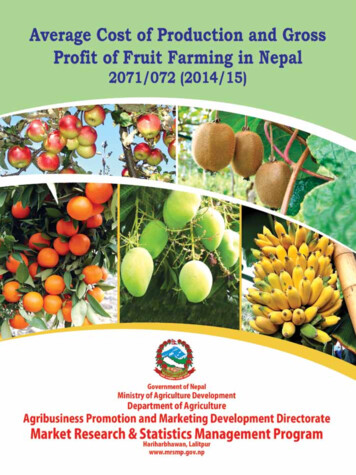
Transcription
Average Cost of Production and Gross Profit of Fruit Farming in Nepal143
Average Cost of Production and GrossProfit of Fruit Farming in Nepal2071/072 ( 2014/15)Netra Bahadur BhandariManiratna AryalGovernment of NepalMinistry of Agriculture DevelopmentDepartment of AgricultureAgribusiness Promotion and Marketing Development DirectorateMarket Research and Statistics Management ProgramHariharbhawan, Lalitpurwww.mrsmp.gov.npAverage Cost of Production and Gross Profit of Fruit Farming in Nepali
iiAverage Cost of Production and Gross Profit of Fruit Farming in Nepal
FOREWORDHorticultural crops are of great importance for increasing theshare of agriculture in Gross Domestic Product of the country.Commercialization of high value and low volume crops farmingin the country is getting momentum at present. Majority of thefarmers are sifting from the farming of agronomic crops tothe horticultural crops nowadays. In this aspect, fruit farmingis gaining popularity among the farmers of Terai, mid-hills and High hills of Nepal.Though farmers are trying to be commercial, there is lack of sufficient research andexperiment in the fruit farming because these crops are perennial in nature. It is necessaryto understand the farm conditions and household characteristics under which they areoperating in order to help the farmers in production planning and resource utilization.In order to assist them substantial information has to be generate and analyzed by farmas far as possible. Profitability of the farm business is a pre-condition for attractingfarmers for increasing the agricultural production in the country. Comparing the costsand benefits of different crops are necessary to device national policies for making thefarm production viable. Survey of the costs of production and then comparison of netreturns to the fixed farm resources from different crops fall under the regular activitiesof Market Research and Statistics Management Program. This is the first attempt topublish the cost of production of fruit crops from this organization. This publication"Average Cost of Production and Gross Profit of Fruit Farming in Nepal" is publishedto help the farmers, agribusiness operators, researchers, academicians, executives andpolicy makers for the first time.I am highly grateful to those farmers and agribusiness operators who provided usefulinformation on the survey for this study. I fully appreciate the efforts and hard worksof staffs involved in field survey, data analysis and writing this report. Special thanksgo to dedicated Agricultural Economist Mr. Maniratna Aryal for his hard work inproducing this report. I am also thankful to Senior Statistical Officer Dinesh Bhattarai,and Agricultural Economists Mr. Kishor Parajuli, Mr. Gokarna Sharma Acharya andMr. Mahendra Kunwar for helping in the field work. I also acknowledge the helpof Padmanath Atreya, Fruit Development Directorate and all the staffs under thisprogramme for their direct and indirect help in completing this study.I welcome reviews, comments and criticisms on this report from the users so that wecan improve it further in the coming years.Netra Bahadur Bhandari,For ChiefAverage Cost of Production and Gross Profit of Fruit Farming in Nepaliii
Technical Committee for Final Approval of Publications1. Deputy Director (Technology Dissemination and Coordination), DoA: President2. Program Director (Agribusiness Promotion and Marketing Development Directorate) : Memberiv3. Chief (Market Research and Statistics Management Program): Member4. Program Directors (Research Concerned Directorate) (3 persons): Members5. Chief (Monitoring and Evaluation Section), DoA: Member6. Private sector (Farmer / Enterpreneur): Member7. Desk Officer, Market Research and Statistics Management Program: Member SecretaryAverage Cost of Production and Gross Profit of Fruit Farming in Nepal
TABLE OF TIONALE.43.METHODOLOGY.44.DEFINITION AND CONCEPTS. 55.5.1 Cost of Production.55.2 Production Condition.55.3 Total Variable Cost.65.3.1 Human Labor.65.3.2 Bullock Labor.75.3.3 Manures and Fertilizers.75.3.4 Irrigation.85.3.5 Seedlings.85.3.6 Other Material Inputs.85.4 Fixed Cost.85.4.1 Land Tax.95.4.2 Other Tax.95.4.3 Depreciation.95.4.4 Repairs and Maintenance.95.5 Interest on Working Capital.105.6 Lease land value.105.7 Management cost. 115.8 Gross Income. 115.9 Benefit Cost Ratio. 115.10 Gross Profit at Farm Gate. 116. Some important information of fruit crops.12Average Cost of Production and Gross Profit of Fruit Farming in Nepalv
6.1 Mandarin Orange (Citrus reticulata).126.2 Sweet Orange (Citrus sinensis). 136.3 Apple (Malus Pumila).146.4 Mango (Mangifera indica).166.5 Litchi (Litchi Chinensis).166.6 Kiwi Fruits (Actinidia deliciousa).176.7 Banana (Musa paradisiaca).186.8 Papaya (Carica papaya ).196.9 Pomegranate (Punica granatum).207. Description of the results.218. Conclusion and Recommendation.22viAverage Cost of Production and Gross Profit of Fruit Farming in Nepal
APPENDICESS.NDistricts1. Mandarin pa1.11Rolpa2. Sweet ge NoDhankuta LocalPokhara LocalLocalLocalDhankuta LocalDhankuta 45LocalLocalLocal4749513. Apple3.13.23.33.4MustangJumlaSolukhumbuHumlaGolden DeliciousRed DeliciousGolden DeliciousGolden Delicious53555759Average Cost of Production and Gross Profit of Fruit Farming in Nepalvii
4. 1737577795. ocal818385878991939597996. calLocalLocal101103105107Average Cost of Production and Gross Profit of Fruit Farming in Nepal
ocal1091111137. iChitwanJhapaKanchanpurWilliam HybridWilliam HybridMalbhogLocalJhapali MalbhogWilliam Hybrid1151171191211231248. alLocal1271291329. BedanaLocalLocal133135137Average Cost of Production and Gross Profit of Fruit Farming in Nepalix
xAverage Cost of Production and Gross Profit of Fruit Farming in Nepal
Average Cost of Production and GrossProfit of Fruit Farming in Nepal1.INTRODUCTIONAgriculture has become a way of life for 65.6% of the people in Nepal. This sectoris contributing nearby 33.6% to the GDP (MoAD, 2014). Moreover, horticulturecontributes 14% to the total agricultural gross domestic Product (AGDP). Agriculturaldiversification and commercialization have drawn attention of the planners andpolicy makers in terms of generating more income, employment opportunities andbiodiversity conservation. The cultivation of high value and low volume cropsand optimum utilization of the available resources for production, processing andmarketing operations has been conceived for the sustainable development of thenation. A twenty years Agriculture Perspective Plan (APP) was implemented since1995 with a view to develop overall economy and thus alleviate poverty. Highvalue Crops emphasized under APP were a) apple in the inner Himalayan zone,b) citrus throughout the mid-hills, c) off-season vegetables in the hill as well asterai, d) vegetable seeds in the hills and mountains. Nepal being rich in climaticdiversity, we have wider scope for the production of various types of fruits andvegetables. Horticultural crops can contribute in food security, improve nutritionalstatus, and provide employment opportunities, increase income and thus increasingthe overall GDP of the country. Compared to the traditional food grain crops likemaize, wheat, rice, fruit farming has been found much more profitable. The areaunder fruits cultivation in Nepal is 1,37,758 (Productive area : 1,01,480 hectare)with total production of 9,38,731 metric tons in 2012/13 (MoAD, 2012/13). Citrusalone contributes about 26.84% of the total fresh fruits production of the country.During fiscal year 2014/15, we have climate as well as land topography very muchsuitable for fruit cultivation. Thus there is need to explore the potentiality of fruitcultivation in Nepal for export promotion as well as import substitution.Average Cost of Production and Gross Profit of Fruit Farming in Nepal1
0002011/122012/132013/14Figure 1 : Productive area and production trend of fruit crops from 2011/12-2013/14 in NepalThe production of fruit was in decreasing trend irrespective of increasing area (Figure1). The production was found greater in 2011/12 compared to the succeeding year.The importance of agriculture sector and its overall development is directly linkedwith the objectives of meeting basic needs of the people. Increasing farm productionand farmers' income depend upon how the farmers plan and manage their farms.Farmers usually do production planning and management in their own judgmentas per individual's family needs. However, they surely can maximize their farmincome by adopting profitable enterprise. Management of resources for maximizingthe returns and minimizing costs as well as improving the overall efficiency offarmers is the major concern of all the institutions involved in uplifting agriculturallivelihood. Information on production cost is fundamental and is helpful to allthe policy makers; agricultural scientist, researchers and farming communitiesincluding the farmers need to be aware.Cost of production is an aggregate of fixed and variable costs incurred in cropproduction. There exists substantial gap in our knowledge concerning criticalaspects of farmers' decision-makers regarding profitability. Managing capabilities2Average Cost of Production and Gross Profit of Fruit Farming in Nepal
of farmers get improved once they come to realize some facts through availableinformation or documents. The data on cost of production can help farmers in theirdecision making process during the selection of profitable business. Farmers getknowledge of profitability in growing suited different agro climatic conditionsby comparing the cost of production of different crops as well as other farmingactivities.The Cost and Benefit analysis of the fruit crop is the first attempt to publish in areport format. Citrus, Apple and Mango were the prime concerned fruit crops of thestudy and it might help in growing, we have put forward an effort to impart somelight this concern as well. Managing capabilities of farmers get improved oncethey come to realize some facts through available information or documents. Therecorded data sets help in recommending the farmers what to grow, how much toplant, which varieties yield higher and subsequent selection of crop types; growingconditions, level of inputs to be used etc. Users get knowledge of profitabilityof growing different crops suited to their agro-climatic area. Data on the cost ofcultivation also play important role in the decision making by the planners and policymakers thereby results in the well being of the farmers. The present report aims tofulfill the above kind of requirement for major agricultural growers concentratingon major fruit crops including Mandarin Orange, Sweet Orange, Mango, Litchi,Kiwi, Pomegranate, Papaya, Apple and Banana.2. OBJECTIVESThe objective of this study is to provide detail information on production costs andgross profits from fruit farming per hectare of major fruit crops.The specific objectives are: To analyze cost of production of different fruit crops by district. To provide data on the cost items and gross profit of major fruit crops underdifferent conditions. To estimate benefit cost ratio of different fruit crops.Average Cost of Production and Gross Profit of Fruit Farming in Nepal3
3. RATIONALEThe yield and input use level, therefore, as it will be noted, will appear to be highercompared to the national average production. Nevertheless, it is hoped that it wouldbe helpful to assess the status of various efficiency indicators and provide basis tojudge appropriate resource allocations by farmers so that the effective costs can bereduced to some extent if possible. In addition this report will also assist towardformulation of appropriate price policy. This data will be a great asset to plan theirfruit farm in future. On the basis of B/C ratio, farmers can select the most profitablefruit crop, plan accordingly and can get more profit from the selected farm business.Value chain is another important tool, on the basis of production; some processingindustries may be established which add value to the product, jobs opportunity andhelp to reduce the poverty in village level.4. METHODOLOGYThe districts are selected on the basis of area of production and in consultationwith district agriculture development office (DADO). Generally, DADO declaredsome VDCs as pocket areas of fruit production on the basis of area cultivation. Thefarms are selected from the pocket area of production. The data was collected byconducting household surveys at different pocket areas of various districts. At least30 households are taken as a sample farms from one district except pomegranateand kiwi fruits. It also uses the published reports of some District AgricultureDevelopment Offices (DADO) on cost of production of fruit crops as part oftheir annual program and the input data supplied by the DADO. Similarly, thewholesale price data is used from the reports of Agribusiness Promotion and MarketDevelopment Directorate. Secondary information regarding the cost of productionand yield of fruit crops were collected from Fruit Development Directorate, Kirtipur.The data were cleaned and processed by the use of Stata software. The results wereobtained by the use of Stata and Excel.4Average Cost of Production and Gross Profit of Fruit Farming in Nepal
5. DEFINITION AND CONCEPTSThe followings are the definitions and concepts used in the study.5.1 Cost of ProductionCost of production is reported in two forms viz. (a) Total cost per hectare and (b)Cost per plant.(a) Total CostThis is the summation of both variable and fixed cost, both costs in cash and kindincluding household labor incurred during the production process.(b) Cost per plantCost per plant is to be computed on the basis of "total cost" minus "value of byproduct" divided by "total number of plants" using the following formula.Cost per Plant Total cost per hectare- Value of by-productsTotal number of plantsHowever, as no by-products were reported to have been valued, the by-product caseis not applicable at this point. So the formula will remain at this moment as:Cost per Plant Total cost per hectareTotal number of plants5.2 Production ConditionProduction condition may vary within and between the districts depending uponits geographical conditions and niches of the respective districts. Varieties of fruitcrops (Local/Improved) under which the crop in question is cultivated. Similarlyother crops under the study comprises of improved cultivars.Average Cost of Production and Gross Profit of Fruit Farming in Nepal5
The cost calculation of perennial crop is different than seasonal/annual crops.Generally, the fruit crops are perennial and produce fruits after 4-5 years of plantation.During this period, farmers may make the use of land to cultivate intercrops whichare seasonal in nature like cereals and vegetables. So, Upto 4-5 years, the farm is inloss position due to no production and just after 4-5 years, fruit plant start to producefruits and the farm may proceed in profit condition. So, It is not good to calculateB/C ratio before production. There are four major components to be considered incost calculation. They are called factors of production like Land, Labor, Capitaland Management. These four factors of production were taken as a major part ofcost of production calculation.5.3 Total Variable CostTotal variable costs are the costs at market price level and incurred both in cash orkind on items such as human labor, bullock labor, seed, manures, irrigation cost,fertilizers, plant protection aids, lease land rent, interest of the capital, Managementcost and other miscellaneous cost. Level of these costs varies depending onproduction locations, technology and scale of production.5.3.1Human LaborHuman labor forms one of the important components of cost involved in cost offruit crop production. It is measured in terms of adult man-day (eight workinghours) in the field.Human labor is expressed in adult man-day. Generally in rural areas, womanworkday and child workday is converted in terms of adult man-day, and it is beingcalculated as it usually practiced.6 1.25 woman days is equivalent to One-man day; implying 1 woman day 0.8 man day. 2 child-days is equivalent to One-man day; implying 1 child day 0.5 manday.Average Cost of Production and Gross Profit of Fruit Farming in Nepal
A. Own Family LaborIt implies the labor contribution on farm by own family members. It is the mainsource of farm labor in case of small and medium sized farms. For estimating suchcosts, family labor has been valued as paid type of labor. Labor taken on exchangebasis is also included in family labor.B. Hired LaborHired labor is the non-family labor employed for farm work on payment on wagesin cash, kind or both. On the basis of work nature, the wage rate is different betweenman and women.5.3.2Bullock LaborBullock labor inputs are measured in terms of bullock day, which means use of apair of bullock for eight hours. Bullock services costs have been calculated at thecurrent market rate per pair of bullock per day. The cost incurred for ploughman isseparately included in the human labor.Nowadays, bullocks are being replaced by tractor in Terai and hilly areas. Thetractor cost is calculated per hour basis. Beside this, for the harvesting of fruit crops,harvesting machines are being used. These machineries will help to save the timeand cost compare to human and bullock labor. These machineries are very useful toincrease the benefit as well as efficiency.5.3.3Manures and FertilizersManures and fertilizers are measured in physical as well as value terms. Marketingof manure is not usual in most of the rural areas of Nepal. As substantial amountof labor is involved in preparation of manure, a minimum cost is assigned. Whiletaking an account of the fertilizers, urea, di-ammonium phosphate (DAP) andmuriate of potash (potash) are commonly available in the market and applied in theAverage Cost of Production and Gross Profit of Fruit Farming in Nepal7
farms. The cost of fertilizers has been calculated on the basis of actual price paidby the farmers.5.3.4IrrigationIrrigation charge or cost incurred while hiring pump-set has been taken as actualamount paid. The labor involvement in irrigating field is accounted in human labor.5.3.5SeedlingsIn case of fruits, seedlings/saplings from seed or different propagation methodsare purchased from government or private nurseries. The seedling price was foundlower from government institutions but the quantity is very low where privatenurseries have enough numbers but the price was found higher. Generally, theseedlings developed from seed will take 5 years to produce fruits but the seedlingsdeveloped from different propagation methods like cutting, layering, grafting etcwill take just 3-4 years to produce fruits. The price of seedlings developed fromseed and from different propagation methods is different. The seedlings developedfrom seed were found lower than different propagation method.5.3.6Other Material InputsMaterial inputs such as pesticides and insecticides have been taken at actual pricepaid have been evaluated accordingly.5.4 Fixed CostFixed costs are those that do not vary with size of enterprise and have no bearingupon decisions to increase or decrease production. It includes land revenue, watertax, depreciation as well as tools and implements and interest in fixed assets.8Average Cost of Production and Gross Profit of Fruit Farming in Nepal
5.4.1Land TaxAgricultural land is classified into upland and lowland. The land survey has dividedeach type of land into 4 categories namely, Abbal, Doyam, Sim and Chahar. Theland tax has been taken as actual tax paid by the farmers.5.4.2Other TaxIt includes water tax and local tax and other governmental taxes if any levied insome special areas for specific unique purpose.5.4.3 DepreciationDepreciation cost is calculated on the basis of purchase value and economic life ofan asset. The economic life of an asset is provided by the company. The formula forcalculating annual depreciation cost is as follows:Depreciation Cost (Purchase value – Scrap value)/Economic life of the farm asset.For those small agricultural tools and implements, which last around a year scrap,value is not taken into account since they are negligible.Farm families have agricultural tools and these are used virtually for almost allcrops. Depreciation charge for each crop is calculated by the following formulae:Depreciation cost/Crop (Area under a crop X Annual depreciation cost)/ Totalcropped area5.4.4Repairs and MaintenanceFarmers in rural areas pay a fixed amount of their main produce to local blacksmithswho provide regular services of repair and maintaining services of agriculturaltools and implements in rural areas. An annual repairing and maintenance cost iscalculated by using the following formula:Average Cost of Production and Gross Profit of Fruit Farming in Nepal9
Repair and Maintenance Area under particular crop fruit quantity paid Price/unitTotal Cropped AreaNormally, payments made by the farmer for the repair and maintenance all the yearround are proportioned as per the crop duration and the area of cultivation.5.5 Interest on Working CapitalInterest on the working capital is charged cash expenses incurred are calculated as10-12 percent per annum (Based on Agricultural Development Bank interest rate)and thus calculated for a particular crop on annual basis and it is incurred in theconditions such as:a. Hired human and bullock laborb. Hired tractor and pump-setc. Other taxesd. Expenses incurred on material inputs such as seeds, chemicals, fertilizers,manures, insecticides and pesticides.5.6 Lease Land ValueLand is another important factor for production. Generally, land leasing is notcommon in fruit crops but it is better to use lease land value for the calculation ofB/C ratio including all factors of production. We have to include the land, labor,capital and management factors for B/C ratio calculation. Then, anyone who isinterested to invest in fruit production business, they are well informed and cancalculate the real cost of production including all factors of production like familylabor cost, land lease value, interest of investment and management cost. In thisstudy, land lease value of hills and mountain is estimated Rs. 1000-1500 per ropaniand in case of Terai Rs. 850-1000 per kattha.10Average Cost of Production and Gross Profit of Fruit Farming in Nepal
5.7 Management CostThe previous studies of cost of production of cereals and vegetables did not includethe management cost. But it is necessary to use the management cost in costcalculation because management is also an important factors of production and fruitcrops are perennial in nature. The life span of fruit crop is generally 25-30 years. Inthis study, Rs. 1500-2000 per month is used as management cost.5.8 Gross IncomeIt is the value of the total crop produce (output) including main and by-productmultiplied by farm gate price.Gross Income Total products Farm gate priceIn case of fruit, the crop started to produce fruits after 3-5 years. Therefore, thegross income will be positive after 5 years only. During the growth period, thebusiness has negative gross income.5.9 Benefit Cost RatioThis is the ratio of the value of output including by-product and the total cost ofproduction on farm gate price.B/C Ratio Gross Income/Total costIf the B/C ratio is above 1, then the farm is earning profit. If the B/C ratio is lessthan 1 or negative, then the farm is in loss. The fruit farm will generate positive B/Cratio after 5 years only.5.10 Gross Profit at Farm GateIt is the difference between the gross income to the total cost considering the productprice at farm gate.Average Cost of Production and Gross Profit of Fruit Farming in Nepal11
6. Some important information of fruit crops6.1 Mandarin Orange (Citrus reticulata)12SNParticularsDetails1Altitude and Temperature 950-1500 masl in the mid-hills, 5oC to 35oC2PlantingAsar-Shrawan (Aug-Sept), Pit digging before2-3 months3Flowering and FruitingMarch-April (Falgun-Chaitra)4HarvestingNovember-December (Aswin-Mangsir)5PropagationGrafting, Seed, Layering, Budding6Manure and fertilizer30-50 kg FYM or compost (2 doko), 544 gmDAP, 874 gm Urea and 833 gm Potash7Plant Density300 plants/ha (15 plants/ropani)8Spacing5m 6m9VarietiesDhankuta local, Pokhara local, Local, Nagpur,Ponkan, KinnowAverage Cost of Production and Gross Profit of Fruit Farming in Nepal
6.2 Sweet Orange (Citrus sinensis)SNParticularsDetails1Altitude800-1400 masl in the mid-hills, 5oC to 35oC2PlantingAsar-Shrawan (Aug-Sept), Pit digging before 2-3months3Flowering and FruitingMarch-April (Falgun-Chaitra)4HarvestingNovember-December (Aswin-Poush)5PropagationGrafting, Seed, Budding, Layering6Manure and fertilizer30-50 kg FYM or compost (2 doko), 250 gm DAP,400 gm Urea and 500 gm Potash7Plant Density300 plants/ha (15 plants/ropani)8Spacing5 m 6 m9VarietiesWasington navel, local, Valencia letAverage Cost of Production and Gross Profit of Fruit Farming in Nepal13
6.3 Apple (Malus pumila)SN Particulars1Altitude7DetailsHigh chilling varieties : 2000-3000 maslMid chilling varieties : 1500-2000 maslLow chilling varieties : 1200-1500 maslPlantingPoush-Magh (December-January), Pit diggingbefore 2-3 monthsFlowering and Fruiting July-August (Shrawan-Bhadra), Feb-March (MaghFalgun)HarvestingAu
Average Cost of Production and Gross Profit of Fruit Farming in Nepal 1 Average Cost of Production and Gross Profit of Fruit Farming in Nepal 1. INTRODUCTION Agriculture has become a way of life for 65.6% of the people in Nepal. This sector is contributing nearby 33.6% to the GDP (MoAD, 2014). Moreover, horticulture





